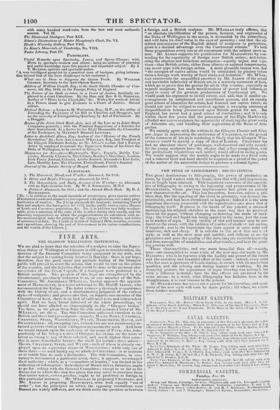FINE ARTS.
THE GLASGOW WELLINGTON TESTIMONIAL.
WE are glad to learn that the selection of a sculptor to raise the Eques- trian Statue of Wellington at Glasgow is still open to consideration, the decision of the General Committee being postponed to tile soth, and that the subject is exciting lively interest in that city : there is yet hope, therefore, that the good sense and patriotic feeling of the Glasgow public will prevail to avert the stigma that would be cast on the artists of the country, and the injustice that would be done to the personal cha- racteristics of the Great Cuptain, if a foreigner were preferred to a British sculptor. The grounds of this hope are strengthened by the circumstance, previously unknown to us, of one member of the Sub' Committee, Mr. ARCHIBALD M`Listasts, having opposed the appoint- ment of MAROCHLTTI, in a letter addressed to Mr. Sheriff Amsos, who recommended the Italian. The letter evinces a thorough acquaintance with the history of art, and a discriminating judgment of the various styles of sculpture; and proves also that, as regards one member of the Committee at least, there is no lack of cultivated taste and independent spirit. had we been better informed of the whole proceedings, we should not have alluded so disparagingly to the " Glasgow bodies." The facts, as we glean them front the able and animated letter of Mr. M.I.ELLAN, are the-e. The Sub-Committee addressed circulars to six British and three fOreign sculptors—namely, Messrs. Buns., Cs al PRELI„ CHANTRLY, STEEL, WnsTstacorr, NVIstris Manocsansrt, Rs rm. and SWANTHALLER : all, excepting two, (which two are not mentioned,) re- turned answers stating their willingness to execute the work And here we would remark upon the exele;itm of the name of' Pa ex, who, inde- pendently of his beiug a nttive of Glasgow, has claims on the score of talent as strong as any of those selected, mid much higher than some : this is more remarkable because the small list includes three artists— Messrs. CHANTREY, STEM., Mid WYATT—each of whom is already em- ployed upon an equestrian statue of' WEntasteros; ; while only one of these three—we need hardly say we allude to Cita WHEY—is so eminent as to entitle hint to such a distinction. The Sub-Committee, in ven- turing to recommend a particular artist, have, it appears, overstepped their authority. ; wink)), as a " committee ol' inquiry.," was limited to the collecting of information : their choice of MAROC11ETTI, therelbre, ought to go for °thing with the General Committee; except in so far as the discussion to which this step has given rise may serve to convince them that native talent, &stasis/ova/pis, ought to be preferred to foreign in this particular instance. Mr. M`LELLans in proposing Cltals.raBv, and a foreign and a British sculptor. Mr. M`LELLast truly affirms, that "an absolute identification of the person, features, and expression of the Duke of Wellington in the statue, is demanded by the subscribers, and will form its chief value in the eyes of posterity ; and that the ads misted preiiminence of the English school of sculpture in portraiture, gives it a decided advantage over the Continental schools." To both these propositions every one at all conversant with the subject must as- sent. Mr. ALISON supports his predilection tbr MAitoenserri by con- tending for the superiority of foreign over British artists; and reiter- ating the obsolete and fallacious assumption—equally unjust and inje. rious—that British artists, either from climate or national temperament, can never cope with foreign artists. A more plausible reason was, that "the energies of native artists would be stbnulated by placing betbre them a foreign work worthy of their study and imitation." Mr. API.1-31,- LAN controverts the unqualified assertion by Mr. ALISON of the actual and inevitable inferiority of British art, in a masterly statement of facts, which go to prove that the genius for art in this country, especially as regards sculpture, has made manifestations of power and refinement equal to some of the greatest productions of Continental art. We would push his argument to its full extent, and add, that if similar en- couragement by enlightened and munificent patrons, and an equally good school of education for artists, had fostered our native talent, we should not now be obliged to contend against a sweeping sentence of disqualification being pronounced upon British genius for art. But England has never had a good school of instructions ; and it is only within these few years that. the possession of the Elgin Marbles has afforded our native sculptors the opportunity of studying the great works of Athenian art, and kindling their aspirations at the flame of Attie genius.
We entirely agree with the writers in the Glasgow Courier and Glas- gow Argus in deprecating the preference of CHANTREY, on the ground of the sameness of his style rendering it likely that his Glasgow Wim- mscrox would be merely a copy of that of Landon. CHANTREY has had an abundant share of patronage, well-deserved and ably canted: let the young sculptors have the chance that a free competition, with the preliminary requisitions well settled, would afford to rising genius. We would suggest that the models ought to be made to a fixed scale, and a colossal head and hand should be required as a proof of the power of the author of the successful design to produce a colossal figure.


























 Previous page
Previous page